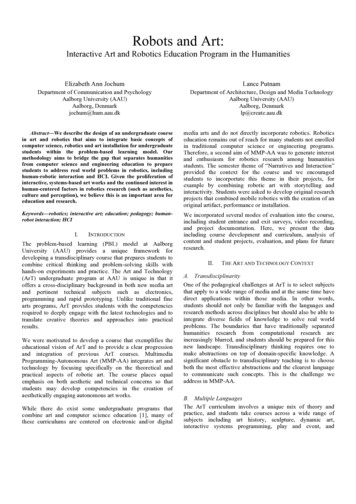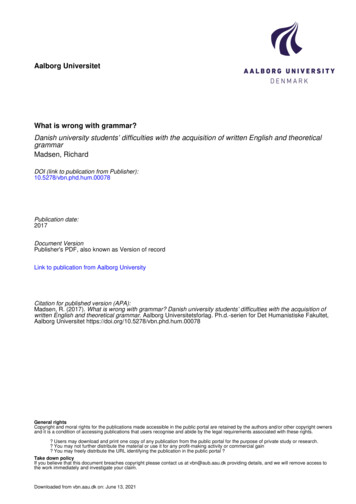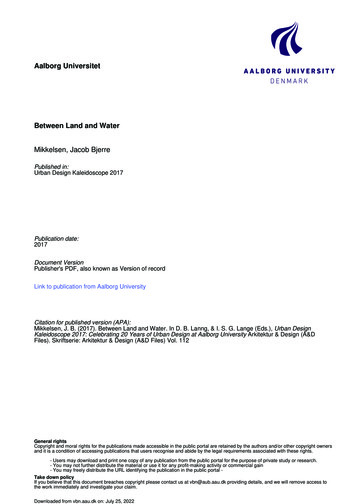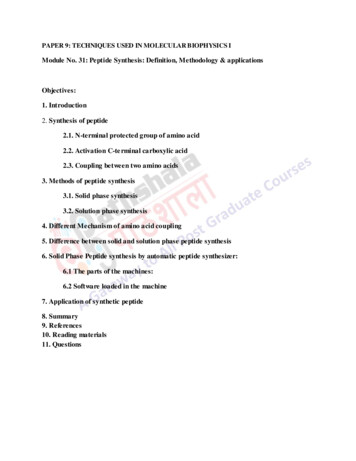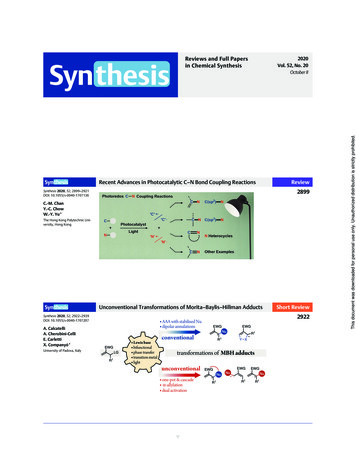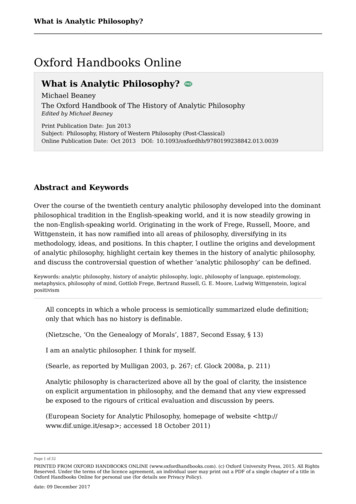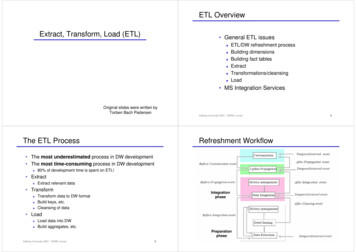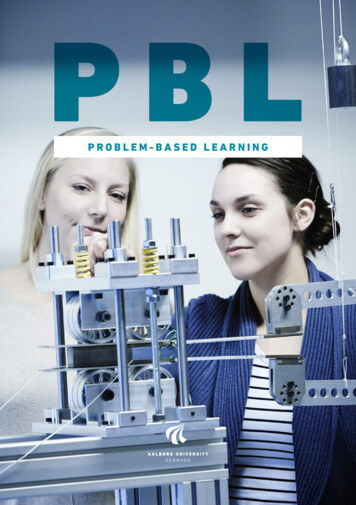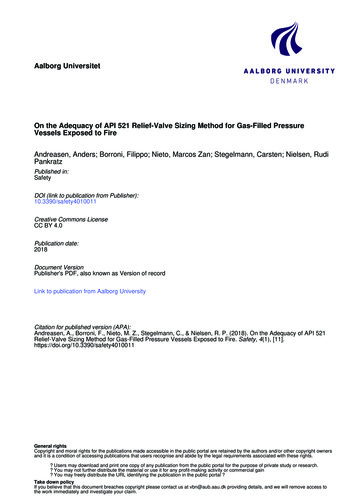
Transcription
Aalborg UniversitetAnalytic synthesis of the effect of foot orthoses on gait biomechanics and pain inpatients with rheumatoid arthritisan explorative experimental and clinical approachSimonsen, Morten BildeDOI (link to publication from Publisher):10.5278/vbn.phd.med.00141Publication date:2020Document VersionPublisher's PDF, also known as Version of recordLink to publication from Aalborg UniversityCitation for published version (APA):Simonsen, M. B. (2020). Analytic synthesis of the effect of foot orthoses on gait biomechanics and pain inpatients with rheumatoid arthritis: an explorative experimental and clinical approach. Aalborg Universitetsforlag.Aalborg Universitet. Det Sundhedsvidenskabelige Fakultet. 141General rightsCopyright and moral rights for the publications made accessible in the public portal are retained by the authors and/or other copyright ownersand it is a condition of accessing publications that users recognise and abide by the legal requirements associated with these rights.- Users may download and print one copy of any publication from the public portal for the purpose of private study or research.- You may not further distribute the material or use it for any profit-making activity or commercial gain- You may freely distribute the URL identifying the publication in the public portal Take down policyIf you believe that this document breaches copyright please contact us at vbn@aub.aau.dk providing details, and we will remove access tothe work immediately and investigate your claim.Downloaded from vbn.aau.dk on: July 20, 2022
ANALYTIC SYNTHESIS OF THEEFFECT OF FOOT ORTHOSES ON GAITBIOMECHANICS AND PAIN IN PATIENTSWITH RHEUMATOID ARTHRITIS:AN EXPLORATIVE EXPERIMENTALAND CLINICAL APPROACHbyMorten Bilde SimonsenD i s s e r tat i o n s u b m i t t e d 2 0 2 0
ANALYTIC SYNTHESIS OF THEEFFECT OF FOOT ORTHOSES ONGAIT BIOMECHANICS AND PAIN INPATIENTS WITH RHEUMATOIDARTHRITIS: AN EXPLORATIVEEXPERIMENTAL AND CLINICALAPPROACHByMorten Bilde SimonsenDissertation submitted 2020.
Dissertation submitted:November 2020PhD supervisors:Associate Professor Rogerio Pessoto HirataAalborg UniversityAssociate Professor Michael Skipper AndersenAalborg UniversityProfessor emeritus Kim Hørslev-Petersen.Danish Hospital for Rheumatic Diseases/University of Southern DenmarkProfessor Peter Derek Christian LeutscherCentre for Clinical ResearchNorth Denmark Regional HospitaPhD committee:Associate Professor Andrew James Thomas StevensonAalborg University (chair)Professor Michael Kjær,Bispebjerg Hospital and Center for Healthy Aging,University of CopenhagenProfessor Reed Ferber,University of CalgaryPhD Series:Faculty of Medicine, Aalborg UniversityDepartment:Department of Clinical MedicineISSN (online): 2246-1302ISBN (online): 978-87-7210-847-6Published by:Aalborg University PressKroghstræde 3DK – 9220 Aalborg ØPhone: 45 99407140aauf@forlag.aau.dkforlag.aau.dk Copyright: Morten Bilde SimonsenPrinted in Denmark by Rosendahls, 2021
CVIn 2013, Morten Bilde Simonsen (MBS) received a Bachelor in Sports Science fromAalborg University, Denmark. He received his master’s degree in Sports Technologyfrom the same university, which included an exchange semester at TechnicalUniversity of Munich.With a grant from TrygFonden, MBS was enrolled as a PhD-student at the doctoralschool of the Faculty of Medicine at Aalborg University. The PhD project is acollaboration between Aalborg University, North Denmark Regional Hospital andDanish Hospital for Rheumatic Diseases. The supervisors are Rogerio Pessoto Hirata,Associate Professor and Michael Skipper Andersen, Associate Professor Peter DerekChristian Leutscher, Professor and Kim Hørslev-Petersen, Professor emeritus.During his PhD, MBS have given presentations at the 42th and 43th InternationalSociety of Biomechanics meeting (ISB), the 8th World Congress of Biomechanics(WCB), the 18th European League Against Rheumatism (EULAR) Congress and theWorld Congress of the 16th International Society for Prosthetics and Orthotics (ISPO).Additionally, MBS won the student award for best presentation at the 10th DanishSociety of Biomechanics. He is also a reviewer at Gait & Posture and invited speakerfor 12th Nordic Congress of Prosthetics and Orthotics in 2021.
PREFACEThis PhD dissertation encompasses research conducted in the period from November2017 to November 2020 at Department of Health Science and Technology, AalborgUniversity and Centre for Clinical Research at North Denmark Regional Hospital.During the PhD study, MBS stayed (January to March 2020) with Professor JamesWoodburn’s research group at Glasgow Caledonian University (GCU) in Scotland.Data analysis and manuscript editorial work in relation to studies III and IV wereperformed during this stay. Furthermore, data collection on a supplementary projectrelated to this PhD was started. Unfortunately, the stay was terminated earlier thanplanned due to the Covid-19 pandemic.This PhD project funded by TrygFonden (124714), The Danish RheumatismAssociation (R161-A5276) and Centre for Clinical Research at North DenmarkRegional Hospital, combines biomechanics and pain assessment, investigatingadaptations to experimentally induced pain in healthy individuals and the effect offoot orthoses in patients with rheumatoid arthritis.The PhD dissertation is presented in six chapters. The first chapter is an introductionto the dissertation where the background, motivation, gaps in the current literature andoutline of the included studies are presented. The second chapter describes the studydesign of the experimental and clinical studies. The third chapter presents key resultsof the included studies. The fourth chapter aims to combine and discuss the findingsof the included studies and shows how they related to each other. Furthermore, a briefcomparison is included of the patients who responded well to the custom-made footorthoses with those who did not. The fifth chapter offers suggestions for futureresearch in this area. Finally, the dissertation is completed with a summary of findingsin all of the included studies.5
ANALYTIC SYNTHESIS OF THE EFFECT OF FOOT ORTHOSES ON GAIT BIOMECHANICS AND PAIN IN PATIENTSWITH RHEUMATOID ARTHRITIS: AN EXPLORATIVE EXPERIMENTAL AND CLINICAL APPROACHLIST OF STUDIESThis dissertation is based on four original articles; two have been published ininternational peer-reviewed journals and two are submitted.Study I: Simonsen, M.B., Yurtsever, A., Næsborg-Andersen, K., Leutscher, P.D.C.,Hørslev-Petersen, K., Andersen, M.S., Hirata, R.P. Tibialis posterior musclepain effects on hip, knee and ankle gait mechanics. Human Movement Science66, 98–108. 2019Study II: Simonsen, M.B., Yurtsever, A., Næsborg-andersen, K., Leutscher, P.D.C.,Hørslev-petersen, K., Hirata, R.P., Andersen, M.S. A parametric study of effectof experimental tibialis posterior muscle pain on joint loading and muscleforces — Implications for patients with rheumatoid arthritis? Gait & Posture72, 102–108. 2019Study III: Simonsen, M.B., Hirata, R.P., Næsborg-andersen, K., Leutscher, P.D.C.,Hørslev-Petersen, K., Woodburn, J., Andersen, M.S.,. Different types of footorthoses effect on gait mechanics in patients with rheumatoid arthritis. Journalof biomechanics, under reviewStudy IV: Simonsen, M.B., Næsborg-andersen, K., Leutscher, P.D.C., HørslevPetersen, K., Woodburn J,. Andersen, M.S., Hirata, R.P., Relief of pain in theankle and the foot in conjunction with altered joint moments in patients withrheumatoid arthritis – outcome of a four-week trial with use of custom-madefoot orthoses. Arthrithis Care & Reseach, under reviewThe dissertation has been submitted for assessment in partial fulfilment of the PhDdegree.6
ENGLISH SUMMARYRheumatoid arthritis (RA) is a chronic autoimmune and inflammatory disease oftencausing foot pain in association with decreased ability to perform daily physicalactivities. Weakening of the muscle and tendon apparatus, synovitis, effusion andeventually erosive arthritis may cause clinically recognizable valgus heel or pesplanovalgus deformity. These manifestations cause changes in the locomotion of thepatient. With the intention to reduce pain, stabilization and alignment of the foot by afoot orthoses (FO) is often recommended in patients with RA.The current PhD project aimed to quantify FO induced changes in biomechanics andpain perception in patients with RA and explore the effect of experimentally inducedtibialis posterior (TP) muscle pain in healthy subjects during gait. Four studies (I-IV)were conducted using an experimental design to induce pain in the TP muscle inhealthy subjects and a clinical intervention design to test the effect of FO in patientswith RA.Results from Study I demonstrated that experimentally induced pain in the TP musclecaused reduced knee and hip joint moments in the healthy subjects. Study II showedthat flexor digitorum longus and flexor hallucis longus can compensate for the TP ifthe strength of the muscle is reduced due to pain. The study highlights the potentialimportance of the plantar flexor and inverter muscles of the foot among individualswith TP pain, which is often seen in patients with RA. Study III investigated theimmediate effect of a custom-made FO for patients with RA compared with a shaminsole. The study showed that the custom-made FO was the most efficient in reducingthe following gait mechanics: the ankle planter flexion and eversion moment, theplanter pressure in the forefoot and the ankle dorsiflexion. The altered mechanics leadto offloading of the plantar flexors and inverter muscles. Study IV demonstrated thatfour weeks custom-made FO therapy reduced foot and ankle pain intensity whilemaintaining the initial biomechanical effects. Furthermore, the custom-made FO alsoreduced the area of perceived pain of the foot, legs, arms and hands.7
ANALYTIC SYNTHESIS OF THE EFFECT OF FOOT ORTHOSES ON GAIT BIOMECHANICS AND PAIN IN PATIENTSWITH RHEUMATOID ARTHRITIS: AN EXPLORATIVE EXPERIMENTAL AND CLINICAL APPROACHIn summary, the first two studies showed how experimental pain models can be usedto study alterations of gait mechanics as a response to pain stimuli. These potentialalterations are important to understand to identify compensation strategies which arecaused by pain or deformities. Study III showed that a custom-made FO reduced theankle plantar flexion and eversion joint moments in patients with RA. Furthermore,Study IV showed that patients with RA benefit from custom-made FO in relation tofoot pain, and possibly also in relation to pain in other parts of the body.8
DANSK RESUMEReumatoid artrit (RA) er en kronisk autoimmun og inflammatorisk sygdom, der ofteforårsager fodsmerter i forbindelse med nedsat evne til at udføre daglige fysiskeaktiviteter. Svækkelse af muskler, sener, effusion og til sidst erosioner kan forårsageplatfods og andre fod deformiteter. Disse manifestationer kan forårsage ændringer ipatientens bevægelse. Med intensionen om at reducerer fodsmerter anbefalesfodortoser (FO) ofte til patienter med RA.Dette Ph.d. projekt sigtede mod at kvantificere de ændringer en FO har på gangbiomekanik og smerter hos patienter med RA, samt udforske effekten afeksperimentelle smerter i tibialis posterior (TP) musklen hos raske forsøgspersoner.Fire studier (I-IV) blev udført, to eksperimentelle hvor smerter blev induceret i TPmusklen hos raske forsøgspersoner og to kliniske interventionsstudier som undersøgteeffekten af FO hos patienter med RA.Resultaterne fra Studie I viste at eksperimentelle smerter i TP musklen forsagerreducerede knæ og hofte ledmomenter. Studie II viste at musklerne flexor digitorumlongus og flexor hallucis longus kam kompensere for TP musklen. Studiernefremhæver vigtigheden af de muskler som udfører plantar fleksion og eversionmusklerne af foden hos personer med TP pain, som ofte observeres hos patienter medRA. Studie III undersøgte den øjeblikkelige biomekaniske effekt af et specialtilpassetFO for patienter med RA sammenlignede med et snyde (kontrol) indlæg. Studiet visteat det specialtilpassede indlæg reducerede ankel plantar fleksion og eversionmomenterne, trykket under forfoden samt ankel dorsifleksion. Disse ændringer vilfører til aflastning af de muskler som udfører planter fleksion og eversion af foden.Studie IV viste at fire ugers anvendelse af det specialtilpassede FO reducerede fod ogankel smerter mens de biomekaniske ændringer fundet i studie III blev fastholdt.Yderligere reducerede det specialtilpassede FO også det areal patienterne opleversmerter fra benene, arme og hænder.9
ANALYTIC SYNTHESIS OF THE EFFECT OF FOOT ORTHOSES ON GAIT BIOMECHANICS AND PAIN IN PATIENTSWITH RHEUMATOID ARTHRITIS: AN EXPLORATIVE EXPERIMENTAL AND CLINICAL APPROACHSammenfattende viste de to første studier, hvordan eksperimentelle smertemodellerkan bruges til at undersøge ændringer i gangmekanik grundet smerte stimuli. Dissepotentielle ændringer er vigtige at forstå, for at identificere kompensationsstrategier,der er forårsaget af smerte eller deformiteter. Studie III viste, at en specialtilpasset FOreducerede ankel plantarfleksionmomentet og eversionsmoment hos patienter medRA. Desuden viste undersøgelse IV, at patienter med RA drager fordel afspecialtilpassede FO i forhold til fodsmerter og muligvis også i forhold til smerter iandre dele af kroppen.10
ACKNOWLEDGEMENTSThe present dissertation could not have been completed without the generousfinancial support from TrygFonden and the Danish Rheumatism Association.Recruitment of patients took place at Department of Rheumatology, Hjørring andDanish Hospital for Rheumatic Diseases, and I thank both staff and the lovely peoplewho volunteered to participate.I would like to thank my supervisor Michael Skipper Andersen for providingoverwhelming support and believing in me, not just during the PhD project but alsoduring the two-year period where we tried to raise funding for the project. Withoutyour guidance, this project would never have been possible. Thank you also to mysupervisor Rogerio Pessoto Hirata for keeping me on my toes and constantlychallenging my understanding of pain; Kim Hørslev-Petersen for your guidance inthe field of rheumatology and for believing in me as a researcher; Peter DerekChristian Leutscher for your attention to detail, for your never-failing optimism andfor helping me to develop a future career within research; Ketill Næsborg-Andersenfor sharing your expertise and driving across the country for making insoles for theparticipants. It has been a privilege to work with you all, I have learned so much andhope to have great collaborations with all of you in the future.Thank you to James Woodburn and his team at Glasgow Caledonian University forletting me visit your laboratory. Unfortunately, we did not manage to finish what westarted due to the COVID-19 pandemic, but I hope it will be possible to continue ourcollaboration in the future.Thank you to my colleagues at Centre for Clinical Research and Sports Sciences forcreating a positive and motivational work environment. A special thanks goes to mycolleagues Aysun, Dorthe, Julie, Anders, Caspar Kent, Mikkel, Ning and Rune.Thank you to Carsten Demant Sørensen from my triathlon club for introducing me toKim Hørslev-Petersen; this turned out to be the starting point for this whole process.Thank you to my family and friends for your support even though you did not alwaysunderstood my work. Last but not least, I would like to thank my girlfriend Merethefor your endless support and for being a source of inspiration.Morten, October 202011
LIST OF WBody weightCNSCentral nervous systemCTComputed tomographyCOMCentre of massDMARDsDisease-modifying anti-rheumatic drugsFOFoot orthosesGRFGround reaction forceMTXMethotrexateOAOsteoarthritisRARheumatoid arthritisSFEShort foot exerciseTPTibialis posteriorVASVisual analogue scale13
ANALYTIC SYNTHESIS OF THE EFFECT OF FOOT ORTHOSES ON GAIT BIOMECHANICS AND PAIN IN PATIENTSWITH RHEUMATOID ARTHRITIS: AN EXPLORATIVE EXPERIMENTAL AND CLINICAL APPROACHTABLE OF CONTENTSChapter 1. Introduction . 171.1 Rheumatoid arthrithis . 171.2 Foot and ankle pain in rheumatoid arthrithis. 181.3 Treating Rhumatoid arthrithis . 191.3.1 Foot orthoses . 201.4 Motion capture and musculoskeletal modeling . 211.4.1 The Muscle recruitment problem . 231.5 Experimental models. 251.6 The effect of pain on motion . 261.7 Knowledge gaps . 281.8 Aims and goals of the PhD project. 291.8.1 Studies: . 30Chapter 2. Study design. 312.1 Experimental tibialis posterior pain studies . 312.1.1 Parametric study . 332.1.2 Statistics . 332.1.3 Ethics. 342.2 Clinical study design . 342.2.1 Patients . 352.2.2 The custom-made FO . 362.2.3 Statistics . 372.2.4 Ethics. 372.3 Defining a responder: supplementary analyses . 382.3.1 Statistics . 38Chapter 3. Results . 393.1 Experimental tibialis posteRior muscle pain . 393.1.1 Pain perception . 393.1.2 Gait adaptions . 403.1.3 Muscle compensations . 4114
3.2Effect of foot orthoses . 433.2.1 Gait 433.2.2 Pain perception . 443.2.3 Daily activity . 463.2.4 Satisfaction and adherence . 463.2.5 Clinical features and demographics of major and minor responders. 475.3 Gait parameters . 49Chapter 4. Discussion . 514.1 The effect of experimental pain on gait. 514.2 Advantageous properties of a foot orthoses for patients with rheumatoid arthritis. 524.3 The effect of four weeks usage of an foot orthoses . 534.4 Major responders versus minor responders . 554.5 Strengths and limitations . 554.5 Conclusions . 56Chapter 5. Future directions . 58Chapter 6. Summary. 59References . 61Appendices . 77Appendix: Study I-IV. 7715
CHAPTER 1. INTRODUCTIONFoot pain is a common musculoskeletal disorder in the general population (Hill et al.,2008). Besides affecting quality of life, foot pain is associated with decreased dailyphysical activities and increased risk for falling (Bowling and Grundy, 1997; Menz etal., 2006, 2005).1.1 RHEUMATOID ARTHRITHISRheumatoid arthritis (RA) is an systemic inflammatory disease causing substantialpain, disability and other morbidities (Klareskog et al., 2009). The first mentions ofRA in written text appeared very early around year 1500 BC, when Ebers Papyrusdescribed a condition similar to RA (Joshi, 2012). However, there is much speculationabout early RA descriptions; Ebers Papyrus is controversial and many believe itreferred to gout. But the first certain discovery of RA is attributed to Dr. AugustinJacob Landré-Beauvais (1772–1840) in 1800. (Halberg, 1995). RA is commonlyconsidered to be a joint disease, but substantial evidence shows that the condition alsomay affect other organ systems such as the eyes, lungs, skin, heart, blood vessels andalmost all other organs (Cobb et al., 1953; Gulati et al., 2018; Kitas and Erb, 2003).In Denmark, it is estimated that 40,000 persons live with RA (Bech et al., 2002; K.Pedersen, 2011; Pedersen et al., 2007) and RA is three times more prevalent amongwomen than men (Fishman and Bar-yehuda, 2010; K. Pedersen, 2011). The diseaseusually develops with onset between 35 and 50 years (Fishman and Bar-yehuda,2010) and despite intensive research, the causes of RA remain unknown (Fishman andBar-yehuda, 2010).The initial symptoms of RA are pain, joint stiffness and joint swelling, often initiallyoccurring in the hands and feet. RA is an autoimmune disease, which means theimmune system by mistake attacks the tissue sounding the joints. The immune systemdestroys the joints by sending out antibodies which causes inflammation in thesynovial of the joints (Song and Kang, 2009). The synovial inflammation in RA isfollowed by cartilage destruction, bone erosion, subsequent joint deformities and17
ANALYTIC SYNTHESIS OF THE EFFECT OF FOOT ORTHOSES ON GAIT BIOMECHANICS AND PAIN IN PATIENTSWITH RHEUMATOID ARTHRITIS: AN EXPLORATIVE EXPERIMENTAL AND CLINICAL APPROACHmalalignment (Klareskog et al., 2009). One of the main characteristics of RA is thatjoint involvement is bilateral (Fishman and Bar-yehuda, 2010).RA often causes distinctive foot pain. The complexity of the foot and the diseasechallenges pain treatment. The joints, tendons and muscles slowly degenerate overtime and synovitis, effusion and eventually erosive arthritis are thought to causevalgus heel or pes planovalgus deformity (Banks and McGlamry, 1987).1.2 FOOT AND ANKLE PAIN IN RHEUMATOID ARTHRITHISMore than 85% of patients with RA experience pain in the feet and ankles during thecourse of the disease, and 57% already within the first year of the diagnosis (van derLeeden et al., 2008). Otter et al. (2010) have shown that pain during the course of RAwas most common in the forefoot (63.9 %) followed by the toes (45.9 %) ankle (42.7%), hindfoot (21.8 % ) and midfoot (17 %) (Otter et al., 2010). Foot and ankle pain isalso the main reason for walking incapacity among patients with RA (Grondal et al.,2008). Walking difficulty due to foot and ankle pain has been reported by 71% of thepatients with RA. This physical limitation has an impact on patients’ quality of life,but it also poses a potential socio-economic challenge due to reduced physical workcapacity.RA can affect the anatomy and function of the foot in different ways. The smallerjoints, tendons and tendon sheaths at the foot are commonly involved in the earlierstages of RA, especially the tibialis posterior tendon and muscle is frequently involvedand increases the risk of developing pes planus deformity and thus additional painseverity (Banks and McGlamry, 1987; Göksel Karatepe et al., 2010; Gulati et al.,2018; Michelson et al., 1995; van der Leeden et al., 2008). Hallux valgus and clawtoes deformities are also commonly observed in patients withRA and themetatarsophalangeal joints are also at increased risk of developing deformity due tosynovitis and high load-bearing (Göksel Karatepe et al., 2010; Gulati et al., 2018;Methods et al., 1963).18
CHAPTER 1. INTRODUCTION1.3 TREATING RHUMATOID ARTHRITHISThere is currently no curative therapy of RA. Therefore, the goal of treatment is todecrease the autoimmune inflammation to prevent development of permanent jointpathology and to reduce pain, leading to improvement of the patient’s overall function(Tanaka, 2013). The first attempts to treat RA focused on very specific regions andincluded alternative medicine such as bloodletting, leeching, acupuncture andmoxibustion. These treatments were not effective in improving conditions (Hart,1976). Instead, the use of disease-modifying anti-rheumatic drugs (DMARDs),especially methotrexate (MTX) dramatically improved treatment outcome in patientswith RA (Black et al., 1964; Sneader, 2005; Weinblatt, 2013). Initially, MTX wasused to treat leukemia (Farber et al., 1948; Sneader, 2005) but later it was shown toalso have a beneficial effect on patients with arthritis (Black et al., 1964; Gubner etal., 1951). By the early 1990’s, low dosing of MTX was established as the standardtreatment for RA (Weinblatt, 2013). MTX is an immunosuppressant drug, whichreduces activity of the immune system and is often combined with other treatmentstrategies. Biological DMARDs have also been included as standard treatments ifMTX is insufficient (Smolen et al., 2016). Biological medicine is a more targetedpharmacological approach, which has made clinical remission achievable for a largerproportion of patients with chronic autoimmune diseases (Burmester et al., 2017).Despite the good effect of biological DMARD, there is still a persistent biomechanicalproblem for several of these patients, relating to specifically foot and ankle pain, butalso to other joints in the body (Gulati et al., 2018; Heijde et al., 2006; van der Leedenet al., 2008). Therefore, overall care including pharmacological treatment should alsoinclude other supplementary therapeutic measures (Hennessy et al., 2016). FootOrthoses (FO) is one of the initiatives that has been gaining increasing attention inrecent years, realizing that biological DMARD is not always sufficient (Hennessy etal., 2016). Therefore, FO still remains a commonly used supplementary therapy forpatients with RA and foot pain (Woodburn et al., 2010). Even though a FO reducesfoot pain and changing the gait pattern, the interaction between these two things is notwell understood (Barn et al., 2014; Hodge et al., 1999; Jackson et al., 2004; Kavlak etal., 2003; MacSween, 1999; Mejjad et al., 2004; Woodburn et al., 2003). This makes19
ANALYTIC SYNTHESIS OF THE EFFECT OF FOOT ORTHOSES ON GAIT BIOMECHANICS AND PAIN IN PATIENTSWITH RHEUMATOID ARTHRITIS: AN EXPLORATIVE EXPERIMENTAL AND CLINICAL APPROACHit difficult to improve the design of FO, since it is uncertain which gait features shouldbe altered to provide optimal pain relief.1.3.1FOOT ORTHOSESDorland’s Medical Dictionary defines FO as a therapeutic in-shoe medical deviceused to support, prevent, align and treat lower extremity, foot deformities andmalalignment (Dorlands Medical Dictionary for Health Consumers, 2007). FOs havebeen used for over two centuries by different health care professionals to treat painand alignment issues in feet and lower extremities. One of the earliest medicalreferences for use of FOs was from a Dutch physician, Peter Camper, who used FOto treat children with flat foot deformities with a FO design with medial longitudinalarch support (Camper, 1861).FO are used for both different purposes and populations (e.g. sport, diabetes, cerebralpalsy and different types of arthritis) (Brehm et al., 2008; Ferber, 2007; Hinman et al.,2012; Kato et al., 1996). Due to these wide groups, several different types of FOdesigns exist. The efficiency of FO in general points in different directions dependingon the design and user population (Ferber, 2007; Landorf and Keenan, 2000; Raja andDewan, 2011). For example, a heat-moldable semi-custom FO had no effect on footkinematics during walking (Ferber and Benson, 2011). Whereas, some types ofprefabricated FOs can be effective in altering foot kinematics during walking (Ferberand Hettinga, 2016). Although FOs are often recommended in rheum
Rheumatoid arthritis (RA) is a chronic autoimmune and inflammatory disease often causing foot pain in association with decreased ability to perform daily physical activities. Weakening of the muscle and tendon apparatus, synovitis, effusion and eventually erosive arthritis may cause clinically recognizable valgus heel or pes
